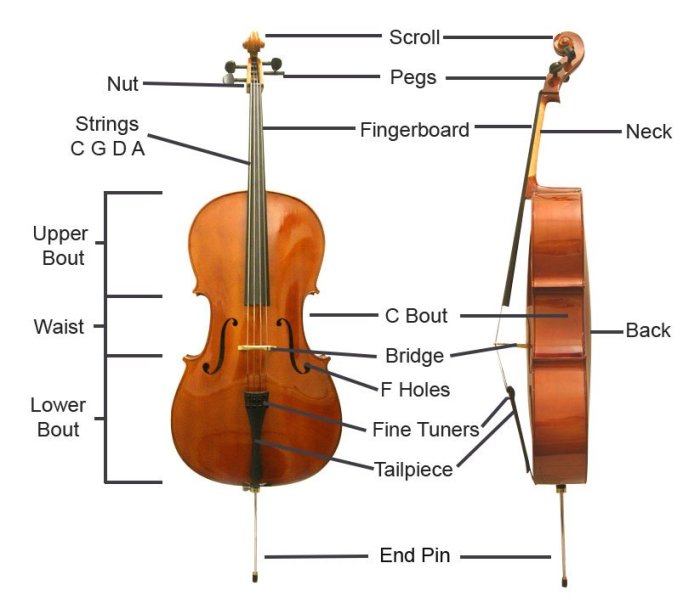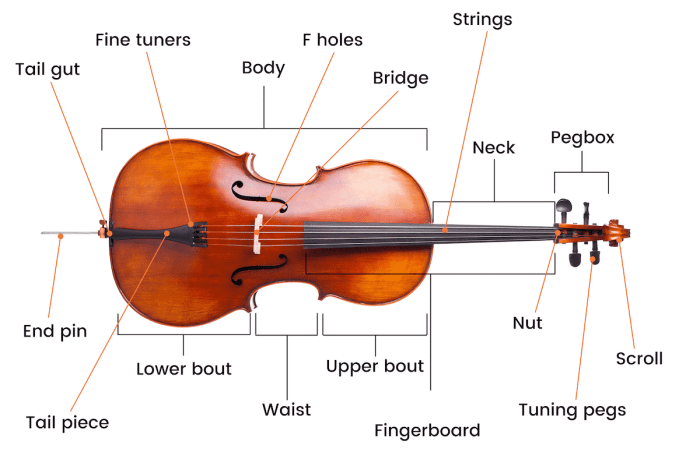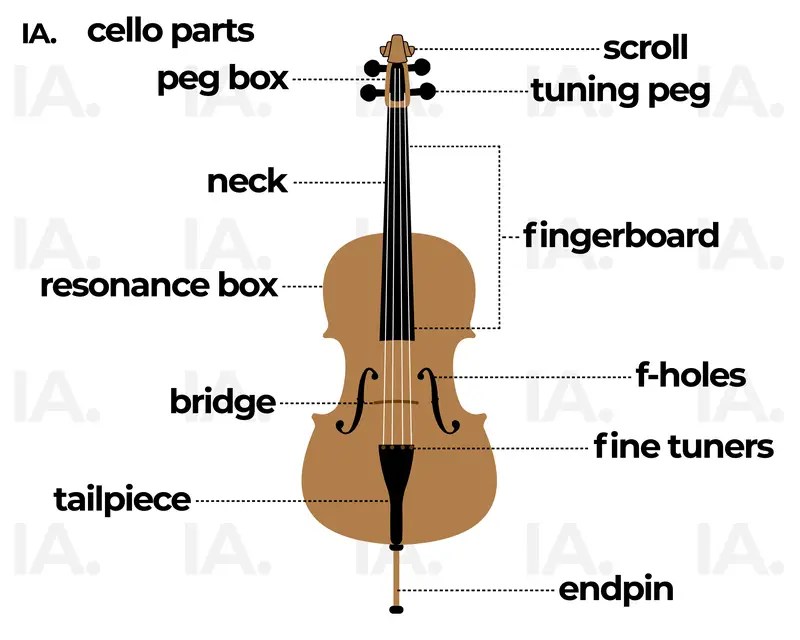Embark on a journey to unravel the intricacies of a cello’s anatomy through our parts of a cello diagram. Discover the harmonious interplay of its components, from the resonant body to the graceful scroll, and gain a deeper appreciation for this captivating instrument.
Delving into the details, we’ll explore the materials and craftsmanship behind each part, unraveling the secrets of its rich sound and timeless beauty.
Cello Anatomy
The cello, a member of the violin family, is a bowed string instrument known for its warm and resonant sound. Understanding its anatomy is crucial for both musicians and enthusiasts.
Body
The cello’s body, crafted from seasoned tonewoods, is the heart of the instrument. It comprises the front and back plates, connected by ribs. The front plate, made of spruce, features sound holes that amplify the vibrations of the strings. The back plate, typically made of maple, provides support and contributes to the instrument’s tonal quality.
Neck
The neck, extending from the body, is made of maple or mahogany. It supports the fingerboard, where the strings are pressed to produce different notes. The neck also features a scroll, an ornate carving at its top that serves as a decorative and structural element.
Endpin
The endpin, made of metal or carbon fiber, is a retractable spike that supports the cello’s weight on the ground. It allows for adjustments in the instrument’s height, ensuring comfortable playing.
Body of the Cello

The cello’s body is the heart of the instrument, responsible for producing the rich and resonant sound that distinguishes it. Its shape is curvaceous and symmetrical, with a waist that curves inward and two C-shaped sound holes on the front.
The size of the body varies depending on the size of the cello, with full-size cellos typically measuring around 75-80 cm in length.
The body of the cello is traditionally crafted from a variety of woods, each with its unique tonal qualities. The most common wood used for the back, ribs, and neck is maple, known for its bright and clear sound. Spruce is often used for the soundboard, as its elasticity allows it to vibrate freely, producing a rich and resonant tone.
Other woods, such as willow, poplar, and rosewood, may also be used, depending on the desired sound and aesthetics.
Soundboard
The soundboard is the most important part of the cello’s body, as it is responsible for transmitting the vibrations of the strings to the air, creating sound. It is a thin, flexible piece of wood that is attached to the ribs and end button.
The soundboard is arched, with a thicker center and thinner edges, allowing it to resonate and amplify the sound.
Ribs
The ribs are the curved pieces of wood that connect the soundboard to the back of the cello. They provide support and shape to the body, and also contribute to the overall sound of the instrument. The ribs are typically made from the same wood as the back and neck, and are often carved with decorative details.
End Button
The end button is a small, cylindrical piece of wood that is attached to the bottom of the cello’s body. It serves as a support for the cello when it is placed on the ground, and also helps to transmit vibrations from the soundboard to the endpin, which is inserted into the floor to anchor the instrument.
Neck of the Cello

The neck of the cello, extending from the body, is a crucial component that allows the player to control the pitch of the strings. Its length and shape are meticulously designed to provide optimal playability and tone.
The fingerboard, a thin, elongated piece of hardwood, is attached to the top of the neck. It serves as the surface upon which the player’s fingers press the strings to produce different notes. The nut, a small piece of bone or hard plastic, is located at the end of the fingerboard closest to the scroll.
It provides a fixed point for the strings, determining their spacing and height above the fingerboard.
The neck and fingerboard are typically crafted from select hardwoods, such as ebony, maple, or rosewood, renowned for their durability and tonal properties. These materials contribute to the overall sound quality of the cello, influencing the clarity and projection of the notes.
Materials
The choice of materials for the neck and fingerboard significantly impacts the cello’s sound and playability. Ebony is a dense and durable wood, known for its dark color and exceptional hardness. It is often used for the fingerboard due to its smooth surface and ability to withstand the constant pressure of the player’s fingers.
Maple, a lighter-colored wood, is frequently employed for the neck due to its strength and resilience. Rosewood, another popular choice, offers a warm and resonant tone, contributing to the overall richness of the cello’s sound.
Pegs
The pegs are wooden or metal tuning devices located at the top of the neck. They are used to adjust the tension of the strings, allowing the player to fine-tune the pitch of the cello. The pegs are inserted into holes in the pegbox, a section of the neck that houses them.
By turning the pegs, the player can tighten or loosen the strings, thereby raising or lowering their pitch.
Understanding the parts of a cello diagram is like observing the intricate details of a bustling city street. The fingerboard, like the sidewalks, guides the musician’s fingers. The strings, like the myriad people passing by, vibrate with energy. The sound post, a crucial element, connects the top and back plates, much like the bridges that span busy intersections.
Just as mucha gente en la calle creates a vibrant atmosphere, the harmonious interplay of these parts produces the cello’s enchanting melodies.
Scroll of the Cello
The scroll is an ornamental and functional part of the cello, located at the top of the neck. It serves as the anchor point for the strings, providing tension and stability. The scroll also contributes to the overall balance and weight distribution of the instrument.The
design of the scroll varies depending on the cello’s maker and style. Common scroll designs include the C-scroll, the S-scroll, and the V-scroll. The C-scroll is the most traditional and widely used, featuring two symmetrical curves that resemble the letter “C.”
The S-scroll is less common, with a single, flowing curve that resembles the letter “S.” The V-scroll is a modern variation, with two sharp angles that form a “V” shape.

It is often adorned with intricate carvings, which can include floral motifs, geometric patterns, or even human figures. These carvings not only add to the aesthetic appeal of the cello but also provide a tactile reference point for the player’s fingers.
Endpin of the Cello

The endpin is a metal rod that extends from the bottom of the cello and rests on the floor. It serves two main purposes: to support the cello and to adjust its height.
The endpin is typically made of steel or aluminum and is adjustable in length. This allows the cellist to adjust the height of the cello so that it is comfortable to play. The endpin should be long enough to reach the floor but not so long that it makes the cello unstable.
Types of Endpins
There are two main types of endpins: spike endpins and rubber endpins.
- Spike endpinshave a sharp point that digs into the floor. This type of endpin is more stable than a rubber endpin, but it can damage floors.
- Rubber endpinshave a rubber tip that grips the floor. This type of endpin is less stable than a spike endpin, but it does not damage floors.
The type of endpin that is best for a particular cellist depends on their playing style and the type of floor they will be playing on.
Strings of the Cello
The strings of a cello play a crucial role in producing the instrument’s distinctive sound. There are four strings, each with a specific pitch and construction.
Materials and Tonal Qualities
Cello strings are made from various materials, including gut, synthetic, and metal. Gut strings, traditionally used, offer a warm and resonant tone. Synthetic strings provide a more consistent and stable sound, while metal strings produce a brighter and more projecting tone.
Diagram of the Strings
The four strings of the cello are arranged in order from lowest to highest pitch, as follows:
- C string: The lowest-pitched string, made of either gut or synthetic material.
- G string: The next highest string, usually made of synthetic or metal material.
- D string: The middle string, typically made of synthetic or metal material.
- A string: The highest-pitched string, made of either gut or synthetic material.
Bow of the Cello: Parts Of A Cello Diagram

The cello bow is a wooden stick with a horsehair string stretched between its ends. It is used to play the cello by drawing it across the strings, causing them to vibrate and produce sound. The bow is typically made of Pernambuco wood, which is strong and flexible.
The horsehair string is usually white or black and is coated with rosin to increase friction.The bow is divided into three main parts: the head, the stick, and the frog. The head is the top part of the bow and contains the screw that is used to tighten or loosen the horsehair string.
The stick is the long, thin part of the bow that is held in the player’s hand. The frog is the bottom part of the bow and contains the button that is used to control the tension of the horsehair string.There
are different types of cello bows, each with its own playing characteristics. The most common type of bow is the French bow, which is characterized by its round stick and slightly curved head. The German bow is another popular type of bow, which is characterized by its octagonal stick and straight head.The
bow is an essential part of the cello and plays a vital role in the sound of the instrument. By varying the speed, pressure, and angle of the bow, the player can produce a wide range of sounds and effects.
Cello Accessories

In addition to the cello itself, various accessories are essential for playing and maintaining the instrument. These accessories enhance the playing experience, protect the cello, and facilitate its use.
The following are some of the most common cello accessories and their functions:
Cello Case, Parts of a cello diagram
- Protects the cello from damage during transportation and storage.
- Typically made of durable materials like fiberglass or carbon fiber.
- May include compartments for accessories and sheet music.
Rosin
- Applied to the bow hair to increase friction and create sound.
- Available in different grades for different playing styles and climates.
- Improves bow grip and prevents slipping.
Tuner
- Used to tune the cello’s strings to the correct pitch.
- Can be electronic or mechanical.
- Ensures accurate intonation and facilitates ensemble playing.
Other Accessories
In addition to the above, other useful cello accessories include:
- Endpin holder: Prevents the endpin from slipping on slippery surfaces.
- Shoulder rest: Provides comfort and support while playing.
- Bow rosin: Used to clean and maintain the bow hair.
- Mute: Dampens the sound of the cello for practice or performance.
- Sheet music stand: Holds sheet music for easy reading.
FAQ Corner
What is the function of the endpin on a cello?
The endpin supports the cello, allowing it to stand upright during playing. It can also be adjusted to alter the height of the instrument for optimal comfort.
What type of wood is commonly used for the body of a cello?
Spruce and maple are the most commonly used woods for cello bodies, prized for their tonal qualities and durability.
What is the role of the fingerboard on a cello?
The fingerboard is where the cellist’s fingers press down on the strings to produce different notes. It is made of ebony or other hard, durable wood.